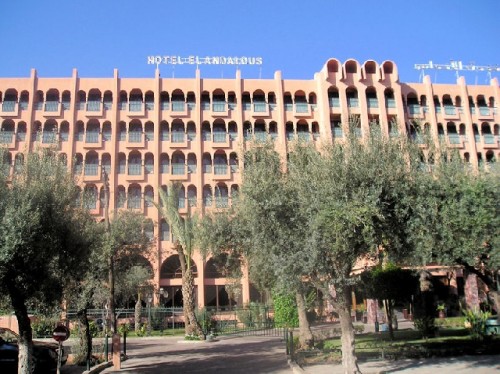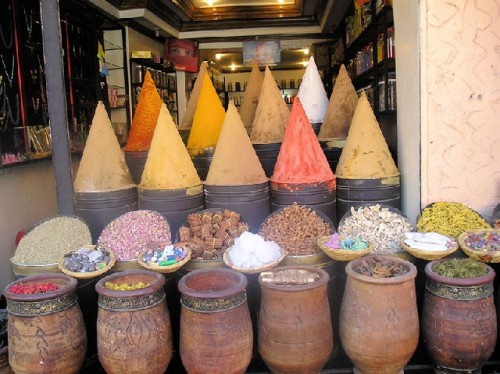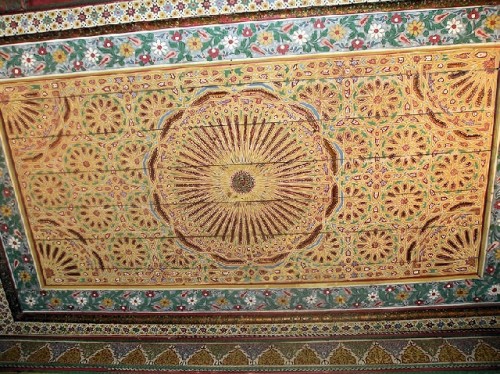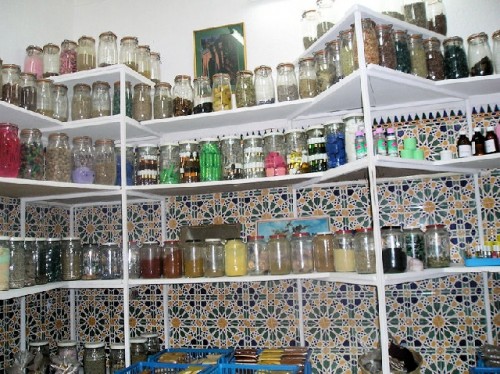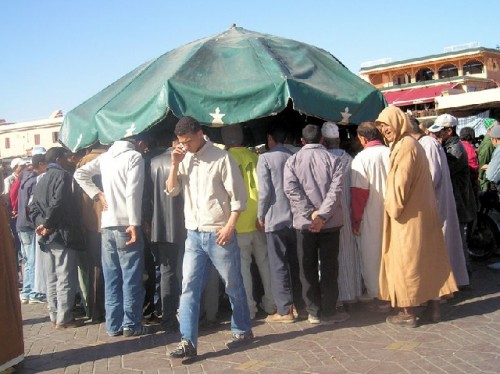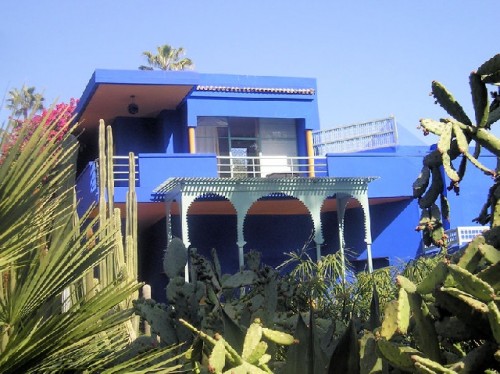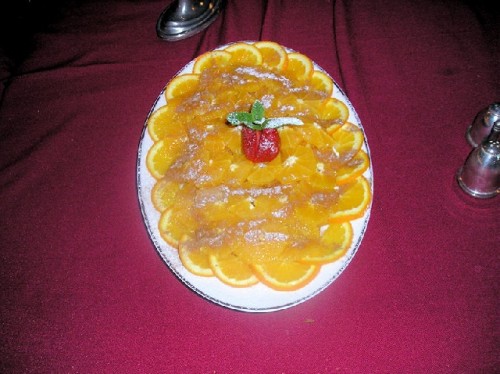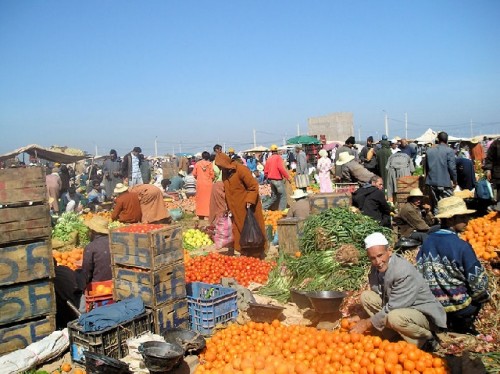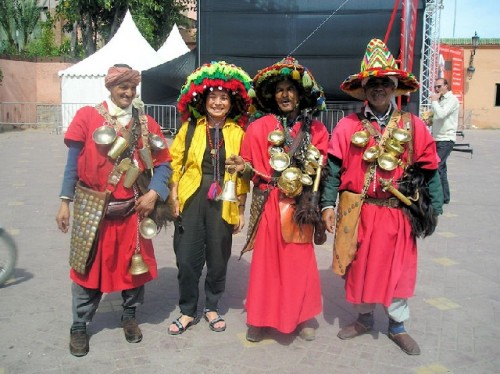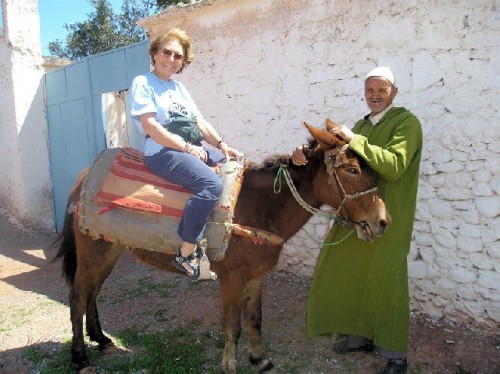Morocco: Part Six
Marrakech
By: Zeren Earls - Dec 23, 2007
Marrakech
In the morning I woke up to bird sounds streaming across the terrace of my hotel room on a beautiful clear day. Following a buffet breakfast for international tourists, mostly French, English and German, we went exploring on a horse-drawn calèche. The first stop was the Bahia Palace, residence of Ahmed Pasha, an honorific title the king gives. Built in the late 19th century it is centered on a courtyard adorned with two fountains by the harem. Past elegance speaks with inlaid wood ceilings, beautiful mosaics and intricate plasterwork. The French have introduced a fireplace. It opens onto an Andalusian garden with flowers of harmonizing colors, scents, and tingling water. Upon the Pasha's death the wives and concubines stripped the palace of all furnishings, leaving only the building.
The Berber pharmacy was both engaging and entertaining. We had a crash course on medicinal plants, essential oils, perfume extracts and traditional cosmetic products. We had an opportunity to fill our shopping baskets with products for allergies, migraine headaches, snoring etc., followed by cosmetics: wheat germ oil for brown spots; rose, almond and avocado oils for smooth skin; lipstick from poppies for hot lips; kohl for eyes and various aphrodisiacs. Last but not least came kitchen spices. Most popular was the Moroccan curry mixture of cardamom, coriander, cumin, ginger and nutmeg.
Jemaa el-Fna Square in the medina, or old quarter, is the heartbeat of Marrakech. Here open-air storytellers, snake charmers and witch doctors ply their trade. UNESCO has designated it as a site to preserve "the oral heritage of humanity". I walked about fortunetellers with tarot cards and beads under umbrellas for the privacy of their customers; enraptured audiences three deep circled the storytellers; plastic body parts identified herbal medicines for the right cure; costumed water-sellers posed for photos; itinerant musicians, orange juice and nut merchants contributed to the amazing buzz.
At sunset the tumult of activity got denser as the square filled up with makeshift restaurants. We returned there to experience the nighttime scene and to have dinner. Each food stand, identified by a number, displayed its menu in both Arabic and French. The aromas from the stalls mixed with billowing smoke from the braziers. We settled at one that Aziz knew and feasted on grilled chicken, beef kebabs and seafood with various accompanying dishes. Afterwards we walked over to the ice cream shop known for its exotic flavors, such as apple, avocado, and fig, along with the many familiar ones. As I walked back with my avocado cone in hand, I had to make my way through the knots of onlookers of acrobats, belly dancers, magic men and henna tattoos, an open-air theater indeed, and an incredible one at that, with hundreds of high-energy performers lit by kerosene lanterns.
The next day we were free to explore on our own. Several of us rode a calèche to the Islamic Art Museum and the Majorelle Garden. Louis Majorelle, a French painter who settled in Marrakech in 1924, became one of the most important plant collectors of his time. The garden has an abundance of vegetal shapes and forms representing five continents. Palms, cacti, bamboo and other exotic plants line the pathways; water lilies, lotus, papyrus and other aquatic plants grow in the reflecting pools. All the garden structures are painted in vivid blue. Yves Saint Laurent has acquired the property and established a trust to ensure the garden's future. The painting studio now houses the Museum of Islamic Art. This small museum treasures needlework and earthenware from different regions of Morocco. Both museum and garden are well worth the visit.
Lunch was yet another unique experience. We had mechoui, roast lamb brushed with butter and hung on a hook inside a covered pit oven to cook slowly. The meat comes out still slightly pink with cracker-crisp skin. After tearing off the meat by hand, we dipped the pieces in salt and cumin, then placed them in between slices of fresh bread. Although I hardly eat red meat, my self-discipline fell apart in Morocco with such tasty dishes.
Along narrow winding streets some of us walked to the Dar Si Said Museum, former palace of the son of the family that ruled Marrakech at the turn of the century. The museum gives insight into the daily lives of the Berbers, founders of Marrakech. In addition to the usual collections of copper and pottery, there are displays of Atlas carpets, jewelry, clothing, bath tools and culinary objects. Also of interest are musical instruments, rustic furniture filled with symbols, and fairground swings used at local festivals until the 1940s. Upstairs is a replica of a bridal chamber.
There was a farewell dinner in honor of those that had opted out of the trip extension in Marrakech. On the way we stopped at a bookstore to get cookbooks. The dinner was an occasion for another feast; this time the restaurant, the Red House, was a former palace. Following a welcome drink in the ornate receiving room, we were served a four-course meal. The noteworthy aspect was the multiple desserts we enjoyed, including a birthday cake delivered by the in-house belly dancer for a fellow traveler. The merriment, hard to replicate at home, convinced me to go to some exotic country for my own birthday.
The four-night post-trip extension was an opportunity to explore the radius of Marrakech. We began with a full-day excursion to the Cascades d'Ouzoud, waterfalls 140 km. north of the city. An impromptu stop for market day in Allattolia revealed sights not seen before. Men sitting at a row of sewing machines performed alterations while people shopped; peddlers sold old clothing and shoes; donkeys got branded; intensely colored spices sat on the ground in conical mounds, their pungent smells mixing with the aromas of stewing chickpeas and fava beans across the way. As we walked around, amazed at the troubling yet fascinating poverty, the locals stared back with equal curiosity.
Dropping down 300 feet in three streams, the waterfalls created a rainbow in the misty air. I descended to the bottom on a narrow path, stopping at different observation areas. Barbary apes that make this moist environment their home enhanced the landscape.
The souk is a labyrinth of alleys crammed with small shops of textiles, carpets, clothing, shoes, slippers, leather bags, brassware, woodcrafts, antique doors, etc. The store, "Les Perles du Sud" (Pearls of the South) carried the best chunky jewelry I have seen. Glass cases displayed one-ofkind silver and semiprecious stone Berber earrings, bracelets and necklaces; amber, coral, lapis and turquoise were all stunning. By now I was able to discern differences between the refined Arab designs and the Berber ones, which are closer to African motifs. I bought two shirts, one of each kind. However, my favorite purchase of all was a decorative multicolored, mirrored leather piece made for a camel.
Marrakech is a city of beautiful gardens for seeking shade in a city known for its summer heat, which can reach 125° F. The Hotel Mamounia, a former palace, has immaculate gardens with an alley of giant olive trees and flowering shrubs that punctuate its formal landscape. Inside I loved the fountain with rose petals floating in its marble tub. Giulin is the upscale neighborhood, where we enjoyed a French meal at La Jacaranda.
Our final excursion was to Amizmiz in the mountains south of Marrakech. By van we climbed, passing Berber villages, terraced wheat fields, almond trees with white blossoms and peach trees with pink ones, until we were at eye level with snowy peaks of the High Atlas.Toubkal is the highest peak at 13,668 feet, Africa's second highest after Klimanjaro at 18,000 feet. We transferred to mules to negotiate the rocky, muddy, up-and-down mountain trails leading to the former Jewish settlement of Mole Ouraze. Jews lived here to mine the salt quarries of the High Atlas. Complete with a synagogue, the abandoned complex is maintained by mountain Berbers, who are paid by city Jews as caretakers.
A farming Berber family hosted us for lunch, where we learned about baking bread in a tandour by sticking the flat dough to the inner wall of the oven. Sitting on floor cushions across from a family portrait of the King with his newborn heir, we enjoyed couscous with chicken and vegetables, as well as beef tajine. While women were cleaning up in the kitchen, the male head of the household and his son showed us around. He had built the two-story house himself using cedar and cane for the ceilings. The wood came from the surrounding forest. Everybody in this village, including my mule driver, spoke French.
On the final day of our tour we had a home-hosted meal of a very different sort. We were guests at the villa of a well-to-do developer, who had also built his own house relying on top-of-the-line craftsmen for the marble floors and the carved detail of the interior. We left our shoes at the door. The family of four with two young daughters, aged four and two, had domestic help. What distinguished this house from others we had seen was its all-Arab décor devoid of any Berber aesthetic, including its rugs. The entire meal, prepared by our hostess, was both a culinary and a visual feast like all Moroccan meals.
Visiting Morocco was a delightful discovery. It is a country blessed with diversity of nature, stunning landscapes, a fascinating mixture of cultures, intoxicating aromas, beauty and friendship. It is also a young country, with 70% of its population under 27 and a high unemployment rate. As it conquers illiteracy and poverty, I am optimistic that it will retain its unique character, which makes Morocco such a compelling travel destination.

